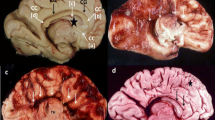Summary
The callosal defect (CD) is of little clinical importance in itself. Therefore, the psychomotor symptoms frequently accompanying it are probably caused by associated brain anomalies. The more common of these are encephaloclastic lesions and malformations based on retarded migration. The frequency with which they occur makes them an important part of the syndrome, especially in regard to the interpretation of the symptoms and diagnostic signs, e.g. the anatomical and pneumoencephalographic appearances of the brain in CD. The picture of “clean” (i.e. uncomplicated) CD may thus be considerably modified or, with respect to isolated features, imitated by the effects of the associated brain lesions. Thus microcrania and microencephaly can be explained on the basis of the associated lesions, patients with “clean” CD having a skull and brain of normal size. A more limited and selective hypoplasia due to focal destruction and malformations is more common. Both cortical abnormalities and lesions of the white matter accentuate the callosal defect by way of tract hypoplasia, reduction in size of the longitudinal bundle and dorsal extension of the lateral ventricles-all features of importance in the diagnosis of CD. These associated lesions may be responsible for additional features not seen in clean CD such as brainstem hypoplasia due to corticospinal tract deficiency, ventricular widening and deformity. Consequently the associated lesions are of great importance from the clinical and diagnostic viewpoints.
Résumé
L'agénésie du corps calleux en elle-même est de peu d'importance du point de vue clinique. De ce fait, les symptômes psychomoteurs qui l'accompagnent fréquemment sont probablement causés par des anomalies cérébrales associées. Parmi celles-ci, les plus courantes sont les lésions encéphaloclastiques et les malformations dûes à des défauts de migration. La fréquence avec lesquelles on les rencontre, en fait une partie importante du syndrome, en particulier quant à l'interprètation des symptômes et des signes diagnostiques par exemple les caractéristiques anatomiques et pneumoencéphalographiques du cerveau en cas d'agénésie du corps calleux. L'image d'agénésie du corps calleux “pure” (c'est-à-dire isolée) peut donc être considérablement modifiée ou compte-tenu des signes isolés, limitée par les manifestations des lésions cérébrales associées. On peut donc attribuer aux lésions associées la microcrânie et la microencéphalie, les malades présentant une agénésie du corps calleux “pure” ayant un crâne et un cerveau de taille normale. Une hypoplasie plus limitée et plus sélective due à une destruction localisée et à des malformations est plus répandue. A la fois, les anomalies corticales et les lésions de la substance blanche accentuent le défaut du corps calleux par l'intermédiaire d'une hypoplasie des faisceaux, par une diminution de volume du faisceau longitudinal et par l'ascension des ventricules latéraux-signes qui tous sont à considérer pour le diagnostic d'agénésie du corps calleux. Ces lésions peuvent être responsables de signes supplémentaires que l'on ne retrouve pas dans une agénésie du corps calleux “pure” telle que l'hypoplasie du tronc cérébral, consécutive à une déficience du faisceau corticospinal, une dilatation et une déformation ventriculaire. Par conséquent, les lésions associées sont d'une importance capitale du point de vue clinique et diagnostic.
Zusammenfassung
Ausführliche Untersuchungen zu dieser Frage, die die Bedeutung der begleitenden Läsionen für den klinischen und diagnostischen Standpunkt herausstellen.
Similar content being viewed by others
References
Banker, B.Q.: Periventricular leukomalacia of infancy. Arch. Neurol. (Chic.) 7, 386–410 (1962)
Davidoff, L.M., Dyke, C.G.: Agenesis of the corpus callosum. Amer. J. Roentgenol. 32, 1–10 (1943)
Ettlinger, G., Blakemore, C.B., Milner, A.D., Wilson, J.: Agenesis of the corpus callosum: A behavioural investigation. Brain 95, 327–346 (1972)
Loeser, J.D., Alvord, E.C.: Clinical pathological correlations in agenesis of the corpus callosum. Neurology (Minneap.) 18, 745–756 (1968)
Marburg, O.: So-called agenesis of the corpus callosum (Callosal defect). Anterior cerebral dysraphism. Arch. Neurol. Psychiat. (Chic.) 61, 297–312 (1949)
Ostertag, R.: Die Mangelbildungen des Commissuren-systems. Der sogenannte Balkenmangel. In: Handbuch der speziellen Anatomie und Histologie, XIII/4. Berlin, Göttingen, Heidelberg: Springer 1956
Persson, G.: Untersuchungen bei drei Fällen mit angeborenem Balkenmangel. Psychiat. Neurol. med. Psychol. (Lpz.) 22, 448–455 (1970)
Probst, F.: Congenital defects of the corpus callosum. Morphology and encephalographic appearance . Acta. radiol. Suppl. 331 (1973)
Rakic, P., Yakovlev, P.I.: Development of the corpus callosum and cavum septi in man. J. comp. Neurol. 132, 45–72 (1968)
Author information
Authors and Affiliations
Additional information
Supported by the Swedish Medical Research Council, Grant No. 12x-2037
Rights and permissions
About this article
Cite this article
Brun, A., Probst, F. The influence of associated cerebral lesions on the morphology of the acallosal brain. A pathological and encephalographic study. Neuroradiology 6, 121–131 (1973). https://doi.org/10.1007/BF00340440
Issue Date:
DOI: https://doi.org/10.1007/BF00340440




